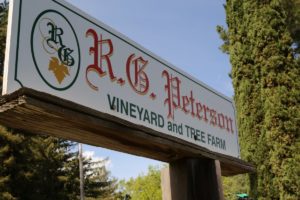 Richard G Peterson Wines is definitely one of the most unique projects in Napa Valley accompanied by a fascinating story as well as nearly 2000 years of history prior to the Wrotham Pinot Noir clone of grapes that were planted in Yountville in the 1980s. Small plantings of this clone now grow in several locations around the world including in the Santa Lucia Highlands of Monterey County, Canterbury in the U.K. (Barnsole Vineyards) and in Michigan (Ca’Musu Farm).
Richard G Peterson Wines is definitely one of the most unique projects in Napa Valley accompanied by a fascinating story as well as nearly 2000 years of history prior to the Wrotham Pinot Noir clone of grapes that were planted in Yountville in the 1980s. Small plantings of this clone now grow in several locations around the world including in the Santa Lucia Highlands of Monterey County, Canterbury in the U.K. (Barnsole Vineyards) and in Michigan (Ca’Musu Farm).
For many years, the Richard Grant wine came from a single 2-acre vineyard of Wrotham clone Pinot Noir (pronounced Roodem), but Richard (Dick) sold his Yountville vineyard and Richard Grant brand in 2016. However, he still has access to the Wrotham grapes that his friend grows in Monterey County and is still producing wine under the Richard G Peterson label although he is no longer using fruit from Napa Valley.
This winery is run by long time vintner Dr. Richard Grant Peterson. At the time our latest update to this review, Richard was entering his 54th year in the wine industry. He began making home wine for the first time in 1948 (from Concord grapes growing in Iowa). As one of the living legends of Napa Valley and beyond he has a storied resume. After graduating from college, he went to work for GALLO in 1958 when they were among the top producers by volume in the nation – which included Roma Winery (the largest winery in California at the time) and the Italian Swiss Colony. By the time Richard left after 10 years GALLO was the number one winery in terms of production. He then went on to become wine master at Beaulieu Vineyards following the famed viticulturist André Tchelistcheff and then later at Monterey Vineyard in Monterey County.
It was at Monterey Vineyard that he invented his ingenious yet simple device which is now found wineries around the planet. It is the steel double barrel pallet (Peterson Pallet) used for stacking barrels on top of each other. Richard never sought a patent for his invention, instead he presented it as a gift to the industry for the first time at WITS (Wine Industry Technical Seminar) in Fresno in 1974. Before his invention he remembers the incredible work and detail that would go into managing wine barrels, moving, rolling, stacking with wood chips, dropping empty barrels onto tires and then catching the barrel as it bounced back into the air, etc. This invention quickly revolutionized the production side of the industry. Within 5 years this pallet was commonly used. In addition, while perhaps not appearing to be earthquake friendly – the Peterson Pallet has already proven itself during a number of earthquakes. Richard remembers one article talking about a number of items that crashed down in a winery during a particular earthquake in California’s Central Coast but how the author made a point to mention that the pallets and the stacked wine barrels remained intact.
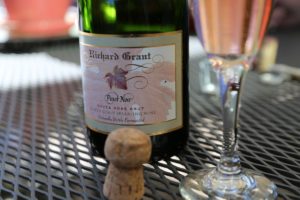 Dr. Peterson also holds several wine related patents including a process to physically inject antibiotics via a screw into the grapevine’s trunk to fight Pierce’s Disease. Ever enjoy a Seagram’s wine cooler? Richard developed their first wine cooler. Richard’s daughters Heidi Peterson Barrett and Holly Peterson continue to have much success in the food & wine industry. Heidi is a much sought-after winemaker and Holly is a well-known chef. Holly even created some special recipes to pair with her father’s Wrotham Pinot Noir.
Dr. Peterson also holds several wine related patents including a process to physically inject antibiotics via a screw into the grapevine’s trunk to fight Pierce’s Disease. Ever enjoy a Seagram’s wine cooler? Richard developed their first wine cooler. Richard’s daughters Heidi Peterson Barrett and Holly Peterson continue to have much success in the food & wine industry. Heidi is a much sought-after winemaker and Holly is a well-known chef. Holly even created some special recipes to pair with her father’s Wrotham Pinot Noir.
Richard has judged (still does) a number of wine competitions; in 1980 he found himself judging a competition in England. Always curious about wine he asked to try some of the local wines and the head of the wine judging said, “have we got the wine for you!”. A very old vine “discovered” in 1950 was growing next to an old stone wall in the village of Wrotham; no one knew anything about this vine other than it was very old and that its leaves looked different from the leaves of most other grapevines. After tasting the wine Richard knew it was a special variety and had some sort of pedigree. He had a plethora of previous experience working with fruit from native rootstock and vines in North America and knew this grape was clearly of much higher quality. He took several cuttings back to the USA where they remained in quarantine for three years at UC Davis; they were found to be completely disease free.
He eventually planted the cuttings among his rose bushes and watched as the cuttings leafed out and over time never contracted powdery mildew while the rose bushes of course had little immunity. This particular selection of Pinot Noir was resistant to powdery mildew, a common fungus that vineyard managers spend much time and money fighting with sulfur and other sprays. As a result, he took some cuttings to UC Davis where they are genetically trying isolate this particular gene(s). If they are successful, this has the potential to completely revolutionize vineyard management and certainly significantly cut down on sulfur uses.
The vineyard was planted in a cooler part of Napa Valley, located in the southern part of the Yountville appellation. The vineyard stood out in stark contrast to typical shiny yellow green grape leaves of the other surrounding vineyards. Richard’s vineyard of Wrotham Pinot Noir was actually a grayish color due to all the small white/grey hairs that cover all of the leaves. Another unusual attribute of this Wrotham selection is during bud break and for a time thereafter the small leaves are a distinctive red/pinkish color. This was certainly the first vineyard of Wrotham Pinot Noir growing in the USA and presently there are not even 4 acres planted worldwide.
Pinot Noir is a varietal that tends to mutate, and sure enough Richard found several mutations in his own small vineyard. One vine produced one shiny yellow green leafed shoot in contrast to the muted whitish/grey leaves found on the rest of the vine. During one harvest he also found one vine produced both red and white fruit. These mutations can then be isolated and once they bear fruit it can be determined if the quality is good enough to continue to propagate them.
Select Wines
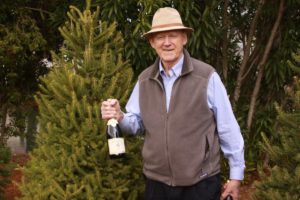 Because of the limited amount of Wrotham grapes Richard makes either a sparkling wine or a red wine each year. There used to be very few Napa Valley based producers making at least one sparkling wine each year – although now, there are many especially those taking advantage of Healdsburg based Rack & Riddle Winery (who has built a business in part on making sparkling wines for other wineries). The Richard Grant sparkling wines are certainly among some of the nicer sparkling wines we have tried on this project. The first vintage of any wine from this vineyard was released in 2000.
Because of the limited amount of Wrotham grapes Richard makes either a sparkling wine or a red wine each year. There used to be very few Napa Valley based producers making at least one sparkling wine each year – although now, there are many especially those taking advantage of Healdsburg based Rack & Riddle Winery (who has built a business in part on making sparkling wines for other wineries). The Richard Grant sparkling wines are certainly among some of the nicer sparkling wines we have tried on this project. The first vintage of any wine from this vineyard was released in 2000.
The 2001 Richard Grant Sparkling Blanc de Noir is a pronounced peach/pink color in the glass with a fine bouquet showing wild strawberry and kiwi notes. The mouth feel is pleasing with just a note of creaminess from the time spent on the yeast. Subtle and delicate red fruit flavors show including strawberry, cranberry and a pleasing note of ruby red grapefruit flavor towards the clean and crisp finish. This wine should be drinkable anytime from release up to 15 to 20 years. During our first visit with Richard, the 2005 was the most recent vintage which wasn’t actually released for several more years.
The 2006 Richard Grant Pinot Noir was his first ever release of a red wine from the Wrotham clone Pinot Noir. Since this is the first table wine from this particular clone Richard is still experimenting with the winemaking side of things including barrel selection and aging. 516 cases of this wine were released. The bouquet offers pretty scents of perfume and is somewhat floral including aromas of violet and lavender with some mineralities present. Ripe red fruit shows on the palate including red cherry, raspberry and plum. This is a fairly smooth Pinot Noir across the palate featuring bright acidity as well as supple structure and a lingering taste of berries on the finish.
From his work at Beaulieu Vineyards Richard discovered that some of Andre Tchelistcheff’s early crafted Pinot Noirs at Beaulieu Vineyard actually held up longer than some of the Cabernet Sauvignons. Richard expects this wine to also age very well.
—
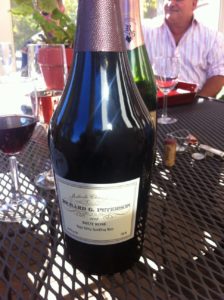 The Wrotham clone dates from at least 1700 years ago when the Romans came to England; the variety probably was used for wine at that time. Fast forward all those centuries ahead to today for the “modern” take on this Pinot Noir selection. Richard’s friend has planted another acre in even cooler Monterey and as a result Richard now has this additional grape source to work with.
The Wrotham clone dates from at least 1700 years ago when the Romans came to England; the variety probably was used for wine at that time. Fast forward all those centuries ahead to today for the “modern” take on this Pinot Noir selection. Richard’s friend has planted another acre in even cooler Monterey and as a result Richard now has this additional grape source to work with.
The fruit from the Monterey vineyard is currently used in his sparkling wine while the fruit from his Napa vineyard was used for the still Pinot Noir.
This particular variety of Pinot Noir while several thousand years old, is certainly so “new” that Richard is still determining the best way to work with it in the winery (oak program, wine making style etc.). It is a variety that prefers cooler weather and the vineyard in Monterey is even cooler than Richard’s vineyard; it will be interesting to see differences between the two vineyards in the coming years. Incidentally the “source” vine in Wrotham died in 1990 but soon thereafter two small seedlings sprouted – which is probably how this vine regenerated itself over almost 2000 years.
Based on Richard’s long-time involvement as a wine judge it is only natural that the wine from his vineyard has been entered into a number of competitions. Out of 1800 entries at a recent National Women’s Wine Competition only 6 double gold medals were awarded, and Richard Grant took home one of these. He has also won a number of medals at other competitions including nationally and internationally.
A wine released in 2014, took 7 years to make and another year in bottle before was the premium Brut Rose bottled under the Richard G Peterson label. The first vintage of this wine is from 2004.
Production is so limited each year (usually under 500 cases) that its distribution is almost all within California. One can find the wines locally at Oakville Grocery in Oakville and often through Richard’s daughter Heidi’s wine brand websites, Au Sommet or Amuse Bouche. For a short while, the wines were sold through Bronco Wine Company.
Note: In August 2015, Richard released a highly personalized 400+ page biography of his decades of work and contributions to the wine industry. This is one wine book you will not want to miss. Read our review here.
Wrotham, UK
This beautiful little village is located about 90 minutes to two hours driving from London Heathrow Airport. The earliest written record of Wrotham dates back to 788. Thank you to the Wrotham Historical Society for helping us with a few last-minute requests relating to Wrotham Pinot Noir. Visit: www.wrothamhistorical.org.uk
In addition to several historic pubs and an old cemetery, this cute town features several other items worth mentioning including Goring Place, a private estate where Jane Austen stayed in 1813 which is also connected through family ownership to the iconic Goring Hotel in London. And The Bull, an ancient inn is within the cozy confines of the village. The Bull was originally built in 1385; it has been called The Bull since soon after it was constructed – it was granted a license to officially conduct business in 1495. Countless owners have overseen its operations over the 600+ years it has been in business. It is the place to stay in town, but especially so for historical aficionados.
A number of local residents have Wrotham vines growing in their backyard including one very large Wrotham vine at one of the homes across from St. George’s Church. Parts of the church date from both the 13th and 15th centuries. And certain stones forming part of a covered walkway on the side of the church were supposedly used by archers for sharpening their arrows (their sharpening marks can still be seen). The church tower contains a clock which dates from 1614.
The main road to London used to pass through Wrotham. Now it is referred to as the Old London Road. And it is at some of these houses that some of the earlier Wrotham Pinot Noir vines may have been planted. In 2019 the St. George’s CEP School planted a single Wrotham vine next to the lawn on the grounds of St. George’s Church.
Generally credited for ‘rediscovering’ the vine was British viticulturist Edward Hyams who discovered a Wrotham vine growing in town in the late 1940s. And in the 1980s a Dudley Quirk (at Chiddingstone) used to grow Wrotham Pinot Noir vines and made a sparkling wine commercially in the 1980s. But when he passed, his operations were shut down.



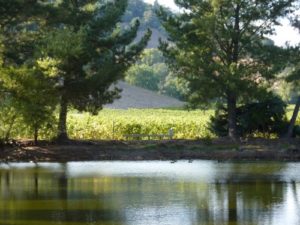
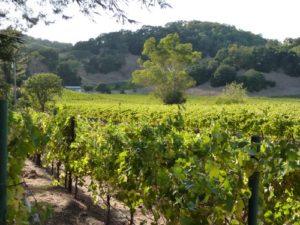
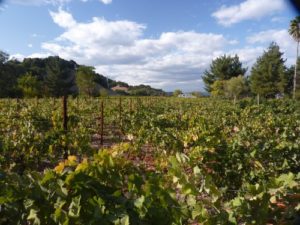
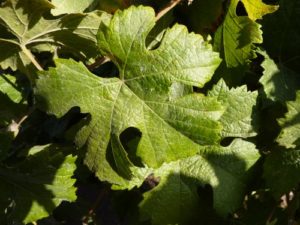
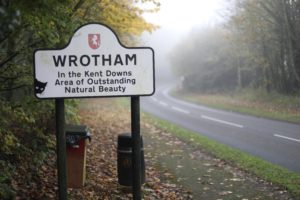



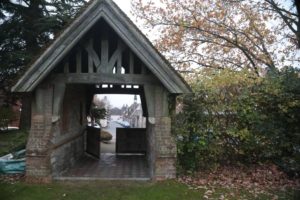
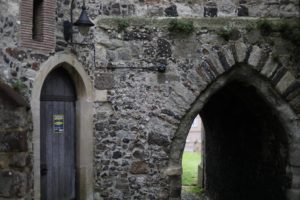
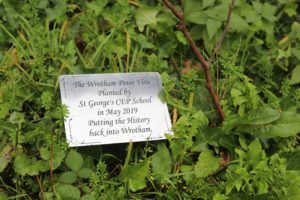
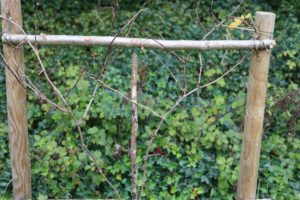

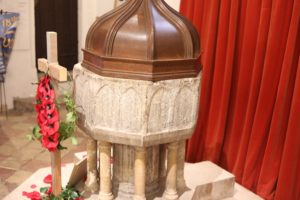
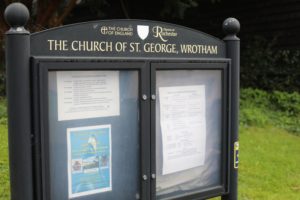

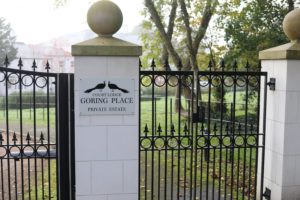



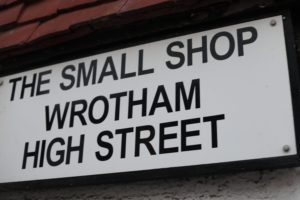

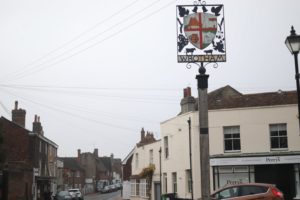
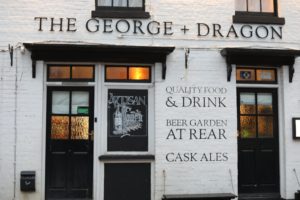
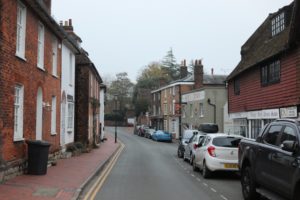
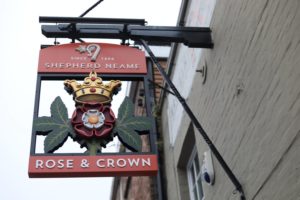


Thanks for the great review. I’m now thinking that the optimum quality for this sparkling Blanc de Noir will come from leaving it on the lees in bottle for four years before disgorging and the best use of oak for the red table wine will be about one year in (part new/part two-year old) French oak followed by a year’s bottle age before release. The 2006 (vintage #1 for this red wine) is bottle-aging beautifully. The problem is that I expect to run out by early 2010. The 2007 should be ready by March 2010 as I bottled it in March 2009. Also, in tune with today’s weak economy I’ve bit the bullet and lowered the retail price of both wines. Sales have jumped accordingly, but I don’t expect to raise the price back up enough to be in the black for another year or so. I’m planning to add a new page to my website listing all the restaurants and wine shops that carry these unique Pinot Noir wines. Thanks again. Richard Grant Peterson
If I recall correctly you had a winery in Berkeley at one time. I also worked for Browne Vintners with Arthur Palumbo. I have a national brokerage company called Haughton & Lane with 14 US brokers & one in Ontario, 67 distributors & handle wines from CA, Sonoma, Carneros, France & Italy.
Do you need distribution in the US & Canada?
Thank you,
Robert
415-302-2576